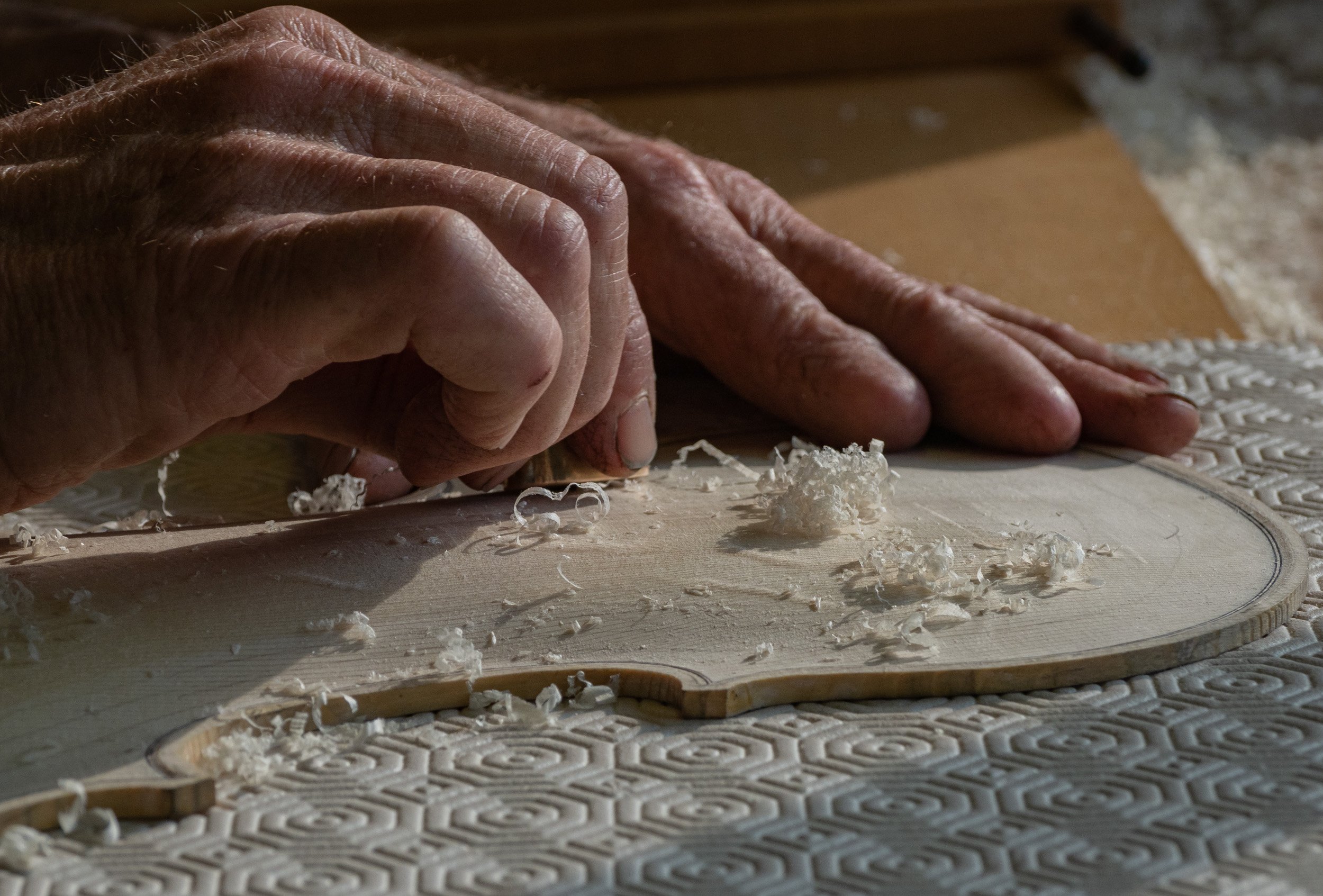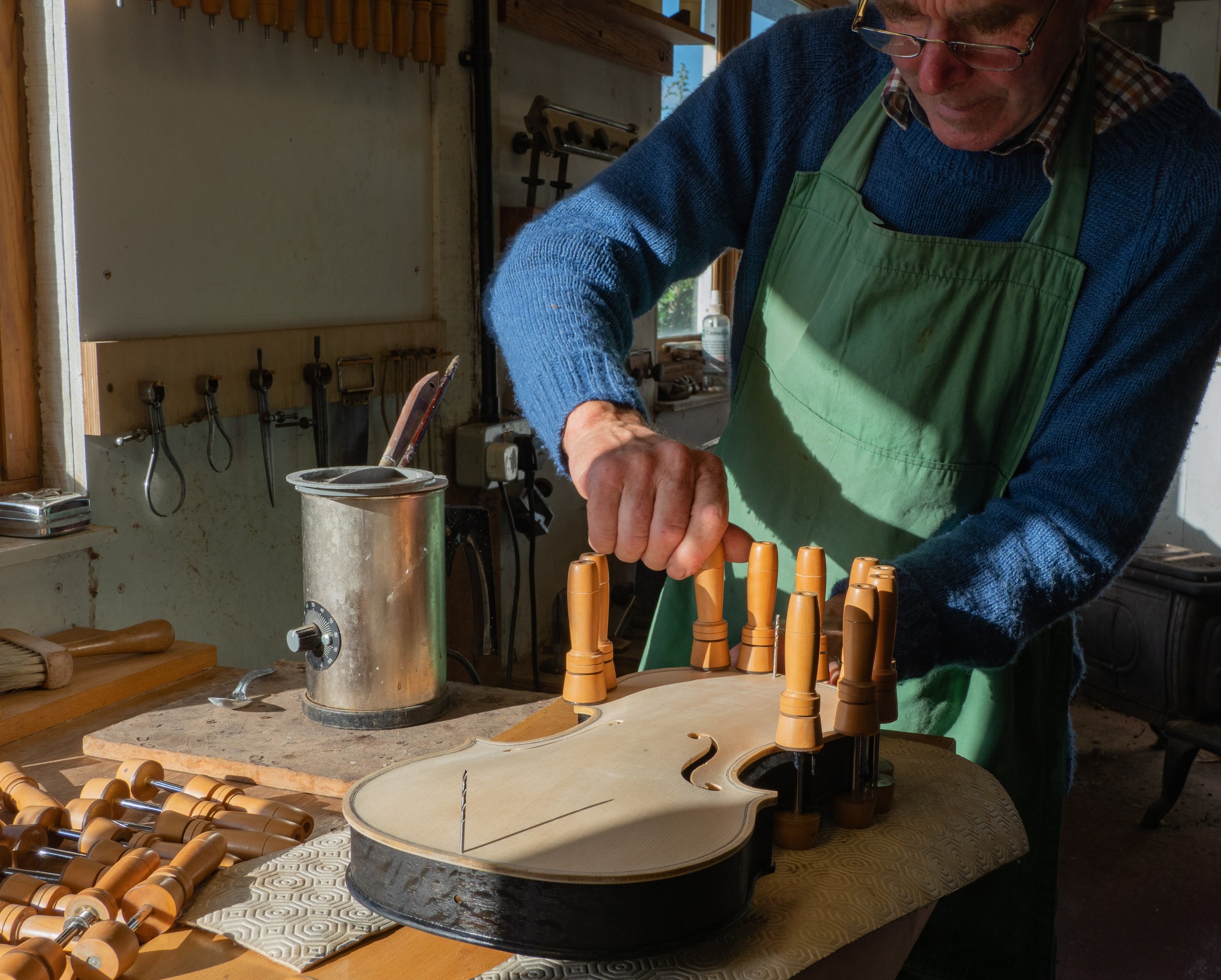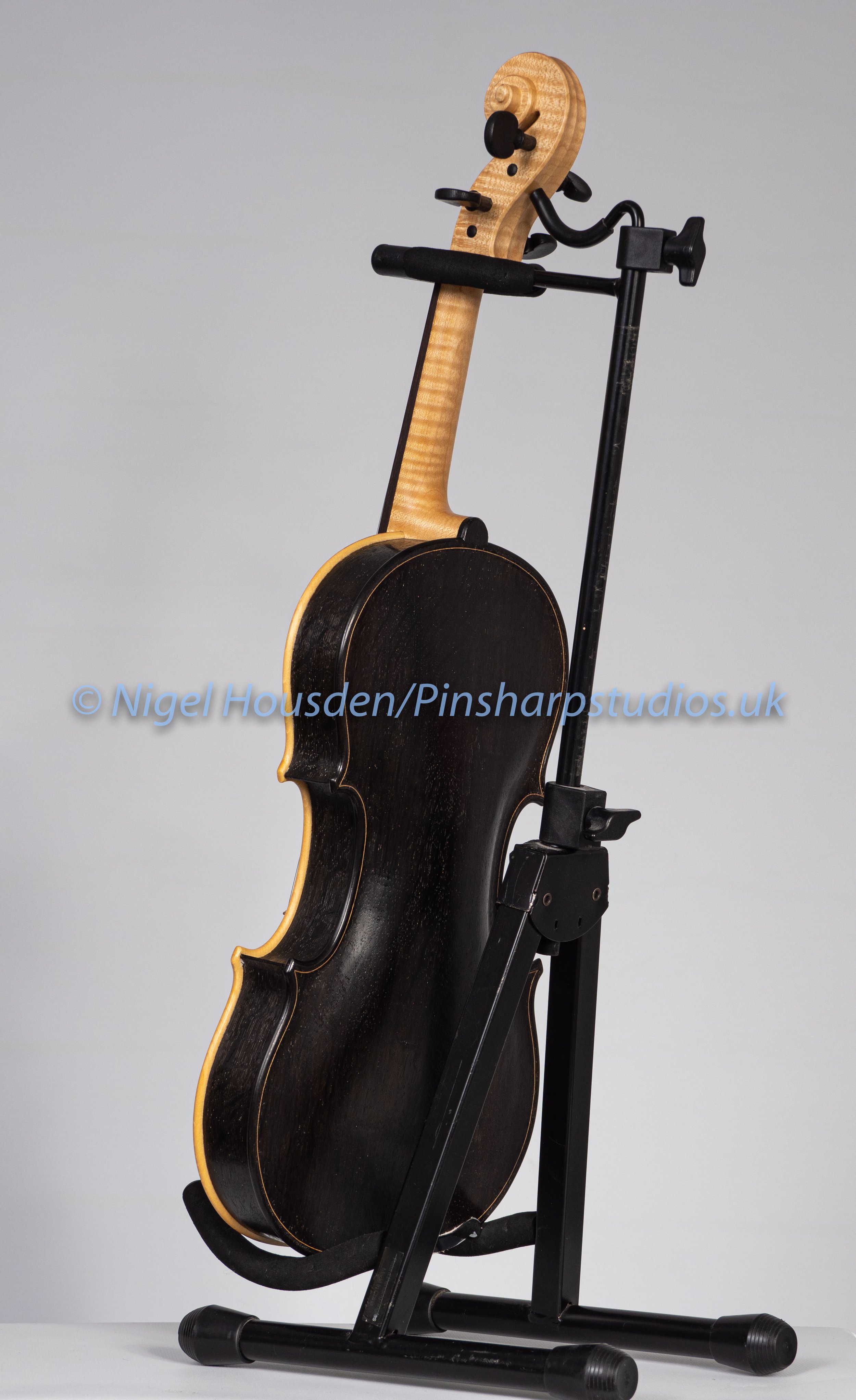
The Unique Black Oak Violin
After some 3000 - 4000 years consumed in a Fenland swamp the ancient tree - a black oak has provided a valuable piece of wood, which has now been fashioned into a magnificent table and exquisite violin.
The only violin of its kind in the world, a stunning instrument, superbly crafted, unique. The video clip from Anglia TV features the violin and the first public airing in Ely Cathedral.
Philip Taylor, who made the instrument, talks about the making on the link below.
Anglia TV News feature.
The Black Oak Violin photographed on the Black Oak Table during the celebration of the tables unveiling and first public performance of the violin, at Ely Cathedral on 17 May 2022.
This is my article on how this magnificent instrument was made, published in Norfolk Magazine last September.
The Black Oak Violin
5,000 Years in the Making
At one o’clock on Tuesday 17 May 2022, under the Octagonal ‘Lantern Tower’ of The Ship of the Fens - Ely Cathedral, a stunning ancient oak table had been placed, cloaked in a large cloth. Stretching down the length of the nave assembled guests sat expectantly, waiting for an historic unveiling. This was no ordinary table, neither were the guitar and violin on exhibition with the table, the latter to be played for a first public airing beneath the Lantern Tower.
Predating the building of Ely Cathedral by over 4,000 years, the 13 meter long table had been made from a single fenland bog oak tree as had the bouts, back and pegs of the violin, the only instrument of its kind in the world. Each plank of the table had been sawn from the mighty oak, the 13 meter length barely representing a quarter of the tree’s original height. This ancient oak had been raised from the black fenland soil just 17 miles north of Ely.
Around 5,000 years ago the Fenland basin was a forested region of huge straight oak trees; by no means resembling the pedunculate oaks found in today’s woods and amongst hedgerows. The massive trees died in the waterlogged conditions, a consequence of a rise in sea levels which caused the rivers to back up, flooding this fenland location. Eventually crashing down into the silt of the forest floor, the oaks were consumed and submerged, to be preserved in perfect anaerobic conditions. Perspective on the timeline of this oak can be gauged from Stonehenge, constructed in the Neolithic period — 2,500BC, whilst the origins of Ely Cathedral date back to the early abbey church founded by St Etheldreda in 672AD. The present cathedral was built in 1083.
Decades of fenland agricultural cultivation has revealed many bog oaks, these have been burnt or simply discarded, but latterly their preservation and use has increased and they are now treasured to be the nation’s most ancient hardwoods and importantly, a tone wood. The intensity of the black nature of the oak wood is a result of soluble irons in the sub soil reacting with the tannins in the oak, this varies from tree to tree, from jet black to a beautiful and subtle colour fade across sawn planks. Further variety is reflected in the wood density which ranges from 300 kg per cubic metre to well over 1000 kg per cubic metre. So far the heaviest has been 1166 kg per cubic metre.
The resurrection of what was to become the Jubilee Oak of 2012, began in March 2012 when an astonishing giant black oak was revealed during farming operations. The scale of this oak tree appears so vast that as it crashed down everything in its path was probably smashed to pieces, in the process the tree buried itself in an airless watery grave. Exhumed, such was the size and magnificence of the oak, it was considered too important to be cut into manageable lengths, where it lay on the fenland soil. The only solution was to saw in situ. To do so the longest sawmill in the country was brought on site, requiring two tele-handlers to undertake the sawing operation. The oak yielded ten stunning consecutively cut planks. These planks became the ‘Table for the Nation’ the Platinum Jubilee Black Oak Table, sitting beneath the Lantern Tower, covered in a cloth which HRH Princess Anne would remove during the unveiling ceremony.
Stunning in its own right, beautifully crafted and imaginatively designed, the table is only part of the story which led to Ely Cathedral on 17 May. From the very same tree which became the table, a separate piece of Black Oak had been selected for a violin. A Norfolk based violin maker - Philip Taylor agreed to create the worlds first and currently only Black Oak violin, a stunningly beautiful and exquisite instrument, unique, it may prove to be the only violin ever to be made from the magnificent ancient oak tree wood.
Making the instrument was to break new ground, where the ribs, back and pegs would be made from the bog oak, the neck and scroll maple, the front spruce. Established and experienced in stringed instrument making and repair, knowing how the oak would resonate, structuring the thickness of ribs and back was going to be a trial and error process. Amidst the history of violin making there are hardly any references to the incorporation of oak in an instrument, any odd instances do no mention the back — the instruments sound board. Philip, always prepared to push the boundaries, is not quite the normal luthier, certainly not programmed by the tradition or mystique surrounding accepted violin making materials or processes.
Immediately, as work began an unexpected problem arose during preparation of the ribs and violin back. A vast amount of black carbon dust, emanating from the ancient oak as it was fashioned and scraped down to the required dimensions, permeated the work bench, ingrained hands with a potential to stain and contaminate the maple and light cream colour of the spruce front. The raw blackness of a partly formed bog oak back, on a workbench littered with dust and shavings is not a factor to consider during the normal making of any stringed instrument. Commenting at the time, Philip said: “at the end of the day my hands were ingrained in the black dust, once the violin was finished the workbench used for the bog oak had to be resurfaced”. The risk of cross contamination was alleviated by segregating the work required on the differing woods, and regular hand washing.
Once the ribs and back were completed they were assembled and sealed in order to prevent any future risk of black dust impregnation. Four pieces of the oak were sent away to a violin peg maker.
Work then focussed on the front, neck and scroll all requiring the same fine attention to detail. An exciting progression, hinting at the unique nature derived from ancient bog oak, married to the instrument makers familiar woods of maple and spruce. An instrument craftsman’s work has a signature, not the signing by pen and ink, but far more subtle; arising through the shape of the scroll, nuances in work on the neck or just a hint from the creation of the two f holes, sculptured into the spruce front. These gradually establish a signature refined to express the makers extensive ability working with beautifully seasoned wood.
Excitement was palpable, tempered by trepidation as the violin was finally assembled leaving only the external varnish finishes to be applied, dry and hardened. And then a first playing, a moment that could turn out to be despair or sublime satisfaction for there was absolutely no means to gauge how the resonance of the black bog oak would react to a violin bow stroking across the finely tuned strings. Every questioning cliché could be levelled against the task of making this particular violin.
The moment of truth arose in Philip’s Norfolk workshop on Sunday 19 December 2021, following many weeks of patient work and dedication, from Bach to English jigs the resonance brought tears of joy and to what became one of his finest Christmas presents. And there were tears amongst some members of the audience in the nave of Ely Cathedral a few months later, as the resonance of Bach’s D minor Partita for Solo Violin swept over the audience gently clothing the historic stone interior. Moved by the performance and relieved, Philip said,“I was very concerned how the violin would project in the vastness of Ely Cathedral, compared to my tiny workshop. But, under the Lantern Tower the expressive beauty of the violin’s expansive resonance and music was so moving that it left me emotionally bereft of words”.
Professional musician - Elizabeth Housden said: “The violin spoke for itself as I drew the bow across the ‘A’ string before the hushed audience. The sound floated down the nave and it responded with absolute clarity to every bow stroke and each musical phrase. The Black Oak Violin is not only unique in the quality of the tone it produces, it is a stand alone instrument of significant character and beauty”.
This violin is unique, the only one of its kind born in part when Ely was just an island above a watery landscape of decaying, submerged giant oak trees. This visually stunning violin spans the eons, exudes supreme craftsmanship and musical resonance beyond any bounds of time.
©Nigel Housden - Pinsharpstudios.uk
All Rights Reserved. Images, audio and text are copyright ©Nigel Housden/Pinsharpstudios.uk

























